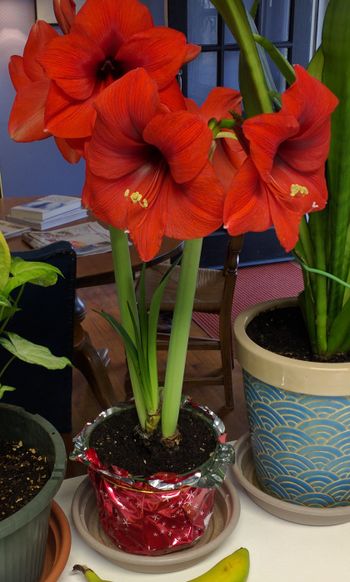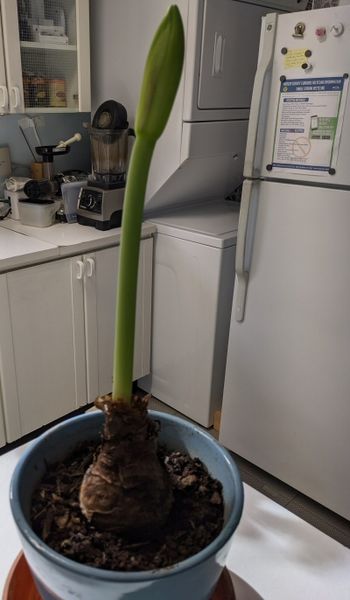Amaryllis: Difference between revisions
imported>Pat Palmer (reversing image positions) |
imported>Pat Palmer (→Propagation: revising, removing parentheses) |
||
| Line 26: | Line 26: | ||
== Propagation == | == Propagation == | ||
There are two means of propagating amaryllis bulbs. The first is by bulb division. A healthy bulb may eventually put out child bulbs to the side, which | There are two means of propagating amaryllis bulbs. The first is by bulb division. A healthy bulb may eventually put out child bulbs to the side, which once large enough possibly after a couple of growing seasons, can be separated carefully from the parent bulb. Alternatively, outdoor blossoms can be left undisturbed after blooming and allowed to "go to seed"; such blossoms may produce small seeds which scatter and germinate in loose soil, or can be harvested. Amaryllis grown from seeds will need to grow multiple years before their bulbs become enough to create blossoms. The first year, their bulbs might reach around a centimeter, or about the size of a U.S. dime. By the second year, the bulb might double in size. After 3-5 years, once the bulb is close to 3 inches in size, the bulb may become strong enough to bloom. | ||
For growers, reproduction by bulb division is preferred, because with seeds, it is impossible to know exactly what color will emerge unless the grower was very carefully able to control the pollination process. | For growers, reproduction by bulb division is preferred, because with seeds, it is impossible to know exactly what color will emerge unless the grower was very carefully able to control the pollination process. | ||
Revision as of 07:57, 16 March 2021
| Hippeastrum | ||||||||||||
|---|---|---|---|---|---|---|---|---|---|---|---|---|
| Scientific classification | ||||||||||||
|
Amaryllis is the common name for a group of showy ornamental perennials in the genus Hippeastrum. Amaryllis is native to tropical South America, and most varieties require protection and care to grow even in temperate climates. Where it is cultivated, the offsets are planted in late summer or early fall for winter-blooming varieties, and early spring for summer-blooming ones. All need a minimum temperature of 55-60° Fahrenheit to grow. Most kinds of amaryllis are derived from the hybrid H. x johnsonii, created in 1799. It descendants include varieties produced flowers ranging in color from deep red to red-orange to white.
Dormancy of bulbs during deep winter
Amaryllis grow from bulbs. Amaryllis foliage cannot survive if temperatures fall below around 50 degree Fahrenheit, and the bulbs (even if embedded in soil and mulched) will seldom survive if temperatures reach freezing. In cooler climates (but still above freezing), the foliage and flower stalks will die down in winter, and then begin growing again as soon as the days begin to length after the winter solstice. In cold climates, people can plant the bulbs outside from spring through fall. But before freezing temperatures arrive, the bulbs need transplanting to pots and moving to a cool storage area such as a basement where they can still receive at least low light. While dormant, they still require water from time to time, as they are not dead. The bulbs will go dormant in late fall as the days shorten, but will begin growing again as soon as the days begin to lengthen. The bulbs can be planted outside again as soon as temperatures stop dropping below about 50 degrees Fahrenheit.
As bulbs begin to grow in early spring, they will try to bloom even before producing foliage. After producing one to three bloom stalks (depending on the strength and maturity of the bulb, as well as growing conditions), the bulb will spend its last energy producing huge, grass-like leaves. The foliage, once in place, begins to nourish the bulb, which bulks up in preparation for the next winter season.
After blooming, the bloom stalks eventually die. Although blossoms can be cut off, the stalk should ideally be left alone until it wilts of its own accord.
Propagation
There are two means of propagating amaryllis bulbs. The first is by bulb division. A healthy bulb may eventually put out child bulbs to the side, which once large enough possibly after a couple of growing seasons, can be separated carefully from the parent bulb. Alternatively, outdoor blossoms can be left undisturbed after blooming and allowed to "go to seed"; such blossoms may produce small seeds which scatter and germinate in loose soil, or can be harvested. Amaryllis grown from seeds will need to grow multiple years before their bulbs become enough to create blossoms. The first year, their bulbs might reach around a centimeter, or about the size of a U.S. dime. By the second year, the bulb might double in size. After 3-5 years, once the bulb is close to 3 inches in size, the bulb may become strong enough to bloom.
For growers, reproduction by bulb division is preferred, because with seeds, it is impossible to know exactly what color will emerge unless the grower was very carefully able to control the pollination process.

